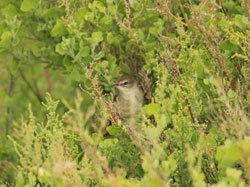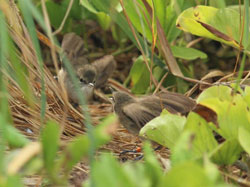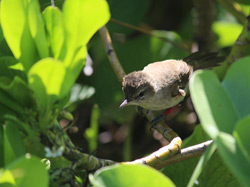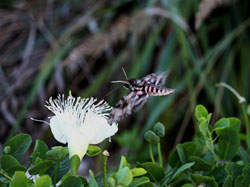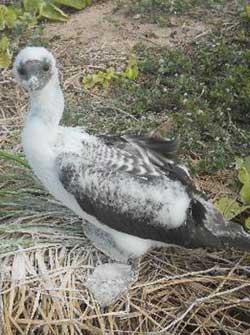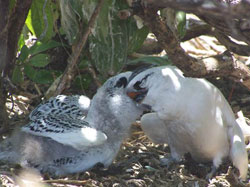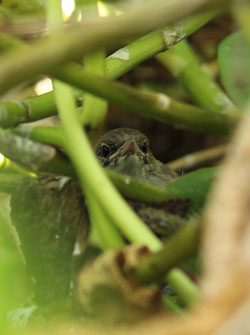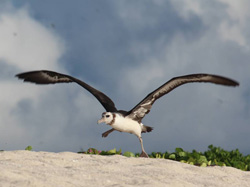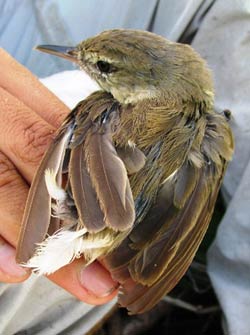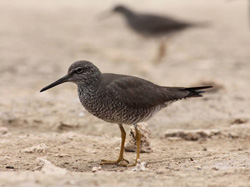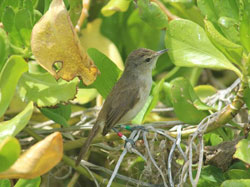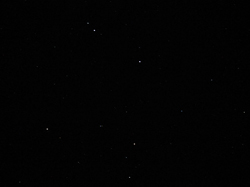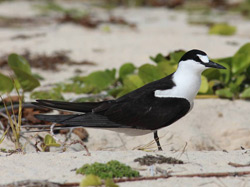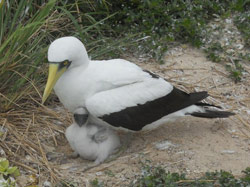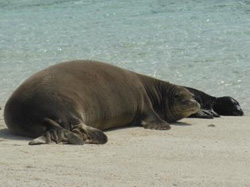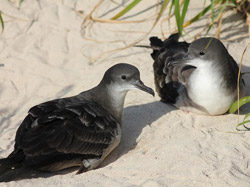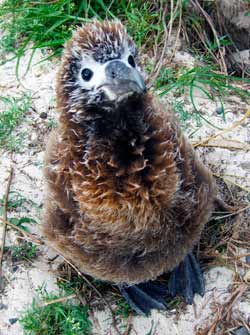
Latest Update on the Nihoa Millerbirds on Laysan Island
– New Hope for Critically Endangered Species
The Millerbird Translocation Project is a partnership of the U.S. Fish and Wildlife Service and American Bird Conservancy within the Papahānaumokuākea Marine National Monument and World Heritage Site. The Monument is managed by the Departments of Interior and Commerce and the State of Hawai'i as Co-Trustees.
Millerbird Drama: Season Finale on Laysan Island
August 26, 2013 - September 8, 2013
By Andrea Kristof
The Millerbirds' fourth breeding wave of the 2013 season continued through our last days on Laysan Island, reflecting the incredible success of our project to ensure a future for this endangered species. Twenty-three pairs are currently displaying breeding behavior ranging from nest construction to feeding nestlings, making it the single largest breeding effort of the season to date.
Simultaneously, the hatch-year birds from the earlier breeding waves are attempting to carve out a place for themselves in the adults' world. We have observed a few young male fledglings from all three previous breeding waves of this year singing recognizable songs (although some of them are still a little raspy) and defending territories. Some of these hatch-year birds have experienced greater success entering the adult world than others. The (probable) hatch-year male that is defending the Southeast-of-the-Knoll territory has been consistently observed in that area, successfully fending off males from the resident, adult pairs to the north and northwest, as well as the intrusion of at least three young hatch-year males attempting to stake out a territory of their own.
This same young male has also been often observed in the company of a hatch-year female from the Northwest Bowl territory, sometimes engaged in courtship behavior with her. To the west, the young Catchment East male momentarily had it all—a prime territory and an interested female—only to have it all taken away one morning by the North-of-Cocos male, whose female (we suspect) ran off with the Catchment East male. He has since been observed singing, alone, in several other areas of the Millerbird core habitat. Along the northeastern fringes of the naupaka, the Pōpolo male has repeatedly lured the South-of-Northeast-Entrance female into his territory. So far, this new pairing has been tenuous and brief, and we've watched the South-of-Northeast-Entrance male venture north several times, chasing this female back into his territory.
These birds have been our version of celebrities this summer, each playing their respective role in the large soap opera that we have been enjoying in the Millerbird core habitat. They were a daily presence in our lives and a constant source of island gossip. We were shocked at the scandals, hopeful at new beginnings, and sad during their absences. As we depart Laysan, I think we will all spend the winter curious about what our Millerbird friends are up to in our absence. Will the Catchment East male ever settle down into a territory and secure a lady friend? Will the younger Pōpolo male successfully seduce the South of Northeast Entrance female away from her current partner? When the next Millerbird monitoring team arrives next year, will territories be established outside of the large northern naupaka patch? Will the 2013 hatch-years be feeding nestlings of their own?
Nature sighting of the week
We observed a sight that has been much anticipated for several years now: a Millerbird in ʻāweoweo (Chenopodium oahuense), a native shrub indigenous to both Nihoa and Laysan. A hatch-year bird from the Knoll territory was resighted on multiple occasions calling and foraging in one of the Chenopodium colonies just downhill from the northern naupaka patch, which has served as the primary residence of the Millerbirds on Laysan Island for the first two years.
Reuniting these two species—bird and plant—required substantial effort and time. In the planning stages of the Millerbird translocation, Chenopodium was identified as an important plant to have on Laysan. It was one of the three species that the Millerbird was known to utilize on Nihoa, the source of the translocated Millerbird population, and was historically abundant on Laysan. However, three years ago, when the Millerbird project team conducted its reconnaissance trip to Laysan, Chenopodium was found to be rare on the island. The shrub faces severe competition from an invasive species, Indian Fleabane (Pluchea indica), which significantly altered the prospective Millerbird habitat adjacent to the lake, outcompeting native vegetation like Chenopodium, the endemic Laysan sedge (Cyperus pennatiformis var. bryanii), and the endangered loulu palm (Pritchardia remota).
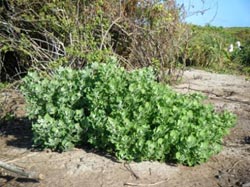
Chenopodium oahuense is planted in areas where the invasive Pluchea indica was removed. This species was historically common on both Laysan and Nihoa (where Millerbirds have been documented to use it extensively). Credit: Andrea Kristof
Chenopodium had relatively recently been reintroduced to Laysan by U.S. Fish and Wildlife (USFWS) Refuge personnel. Although early biological accounts from Laysan report that Chenopodium was the second-most abundant plant on the island, the introduction of rabbits caused its extirpation in the early 1900s. Seeing a Millerbird utilize this species is a wonderful culmination of countless hours of invasive species control and native plant propagation. We had already observed how these restoration efforts benefit many members of Laysan's ecosystem, but the presence of a Millerbird was definitely a landmark event.
Farewell to Laysan
This week USFWS Refuges commenced the closure of the Laysan Island field camp due to the impacts of sequestration. It has been difficult to contemplate leaving, because invasive plants that field crews have worked to eradicate for more than two decades could easily regain the upper hand. Rare and endangered native plants might be out-competed.
But seeing the Millerbird foraging in the Chenopodium reminds me of all that has been accomplished in the last few years, and I hope that the positive actions that many dedicated people have contributed to restoring Laysan's ecosystem will continue to resonate through future years. Just over the course of my short four years working on Laysan, there are three native species that once again call Laysan home after a century-long absence. There are also two non-native species that we eradicated from Laysan.
I like to envision that, in another five years, the young, endangered loulu palms that were planted along the eastern lakeshore will have matured into three-meter-tall fan palms visible from the western coast. I can imagine their broad fronds providing a much-needed respite from the summer sun for Laysan Albatross chicks, and their yellow flowers and juicy purple fruits providing an appetizing delicacy for the voracious Laysan Finches.
In seven years, perhaps some of the albatross chicks that we excavated when they'd been buried by wind-blown sand in the Northern Desert—a human-created desert, an unfortunate reminder of a rabbit introduction that denuded the island of its vegetation over a century ago—will return to their natal island in search of a mate. A couple of decades from now, I hope that some of the straggler green sea turtle hatchlings that we unearthed during nest excavations and protected from the zealous claws of ghost crabs as they made their way into the ocean will crawl out of the water one moonlit summer night to lay eggs of their own.
And I very much hope that sooner rather than later, a field crew will be restored to Laysan Island, so that past restoration work can be salvaged, so that the ecosystem can continue to be restored and monitored, and so that the biological wonders that occur here can be experienced by a new generation of conservation biologists.
Multi-tasking Millerbird Parents
August 12, 2013 - August 25, 2013
By Megan Dalton
For most of the last two weeks, we did not find any new Millerbird chicks, so our tally for the 2013 breeding season was stuck at 48. However, due to a very sneaky, very busy pair in the territory on the southern side of the core Millerbird habitat we call Sickly Sicyos (due to a lot of unhealthy-looking viney Sicyos sp.), the total fledgling number is now the nice and clean number of 50! This is a great benchmark for the birds and the overall Millerbird translocation project, as we prepare to leave Laysan in three weeks.
Those two stealthy Millerbird parents have had us scratching our heads since June, when they built a lovely nest in a naupaka shrub but did not lay eggs. Since then we've seen a couple of signs that made us wonder if they were re-nesting in the same shrub, yet we could never find any definitive evidence. Most birds had paused all breeding activity in order to molt, and this was a relatively inexperienced pair, so we underestimated their potential. We were all pleasantly surprised earlier this week when Michelle saw the male with color band combo, W/G:BK/B, bringing food to an enthusiastically begging, unbanded fledgling multiple times in the very same shrub where they had attempted to nest before. Another beggar was heard in a bush nearby where the female with color band combo, W/W:B/W (who is currently without a tail due to molting), was hanging out. Since they normally split up feeding duties between chicks, it made sense that there were at least two fledglings in this brood.
The pair's successful breeding during their period of molt is a testament to their perseverance, but also to the high-quality habitat offered by Laysan. There must be sufficient food items available to get them through the extremely energetically taxing time of re-growing all their feathers, while simultaneously staying in peak condition to reproduce and provide for their young. Amazing!
Nature sighting of the week
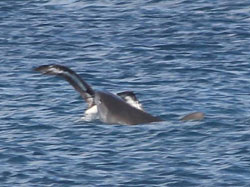
Although this doesn't look like it ends well for the Laysan Albatross, this lucky fledgling was able to escape the imminent jaws of a large Tiger Shark. Credit: Michelle Wilcox.
Someone recently reminded us that it was Shark Week a few weeks ago, at least back in the land of cable television. Out here on Laysan, it seems like Shark Week has lasted over a month. You may have heard of the seasonal tiger shark migration throughout the Northwestern Hawaiian Islands to shallow waters surrounding albatross colonies. Around July and August, right when the majority of albatross chicks are making their first trek out to sea, large numbers of tiger sharks show up to chow down on the naïve and clumsy chicks. On Laysan, attacks are usually seen in waters off the southern edge of the island, as well as in a southwestern bay fronting the large beach nicknamed The Sidewalk. Keeping this in mind, I was walking south from camp along the shore one day, periodically scanning the ocean and listening for any sudden splashes. When I hit The Sidewalk, I sat down and got out my binoculars and focused on a few birds out in the bay. The first bird I trained my eyes on got gulped down quickly by a rather large and sleek shark. Not five seconds later, a second nearby bird was also attacked. This time it took the shark three tries to actually seize the terrified albatross. I have to confess that my heart felt like it was racing and simultaneously breaking. I was thrilled to see such a real, raw, and essential act of nature – it isn't often that I find myself in the presence of such a powerful predator. On the other hand, we have spent nearly five months watching our albatross neighbors struggle to regularly provide for their chicks. A number of them don't seem to survive to fledging, so it was terribly sad to see these ones who are so close to making it traveling down the toothy gullet of a large shark. But obviously I'm biased, and I haven't spent months underwater watching all the sharks' struggles of survival. (Plus the albatrosses are cuter).
In other news on Laysan
An unknown species of duck was seen twice in the last two weeks. Because it was skittish and easily flushed from far distances, we were unable to get a good look at it except that it appeared dark colored and had a very short tail. The lakeshore is once again bustling with shorebird activity as more Pacific Golden-Plovers, Ruddy Turnstones and Wandering Tattlers arrive. Wedge-tailed Shearwater chicks are hatching in droves, Sooty Tern chicks are taking to the air, Brown Noddy chicks have begun to shuffle around on their little feet and the Bonin Petrels have started working on their burrows in preparation for their breeding season. Red-footed Boobies and Great Frigatebird chicks continue to grow as they sit upon their stick nests; they are slowly replacing their down with body contour feathers and flight feathers. There are plenty of Red-tailed Tropicbird chicks underneath the vegetation, some old enough to fledge, others more recently hatched.
Join us in a couple weeks for our final 2013 posting about the Millerbirds on Laysan.
A new cycle begins
July 29, 2013 - August 11, 2013
By Andrea Kristof
After a brief vacation from the demands of parenting, the Millerbirds of Laysan are emerging from their molting period and initiating the fourth wave of breeding this calendar year. The fledglings from the 2013 breeding season, that only two weeks ago wandered through the Millerbird core habitat carefree and unhindered, are now being actively chased to the margins of territories by the resident breeders. The adult males have resumed singing, pairs have been observed carrying nesting material, and we have located 10 new nest.
But perhaps the most exciting and anticipated event of this two-week interval was the addition of 2013 hatch-years (birds that were hatched in the 2013 breeding season) to the Millerbird chorus. On August 9, we observed the first hatch-year male, a banded bird that fledged from the Northwest Bowl territory on April 14, displaying territorial behavior and singing a fully-developed song. This individual was embroiled in a very lengthy dispute with an unbanded male (probably another hatch-year) over a patch of shrubby real estate in the northeastern part of the Millerbird core habitat, an area far from his natal territory in the northwestern core region.
Nature sighting of the week
The warm weather of August has brought with it an explosion of insect activity on Laysan Island. The house flies, which until recently had been abundant, but manageable, now blanket our arms, faces, hats, and backpacks in writhing black masses. A Millerbird field technician might hope that the silver lining of this discomfort would be that this inescapable insect buffet would entice the insectivorous Millerbirds to come closer and facilitate resighting their bands. Unfortunately, although we've observed Millerbirds dining on the flies surrounding the carcasses of dead seabirds, they have not yet expressed the same enthusiasm for the clouds of flies that encircle us.
Another element of the insect assemblage that has recently come into prominence is the sphinx moth (Family Sphingidae). The sphinx moth is a large moth—with its wings extended, it is nearly half the size of the palm of my hand—with ornately patterned cream-colored wings and pink stripes adorning the sides of its abdomen. Although typically a rare sight on Laysan, these creatures have become a common daily occurrence over the past couple weeks in the naupaka that makes up the core Millerbird habitat. We've caught them while mist netting, watched them make long distance flights over the naupaka, and also observed them foraging among the beach morning glory flowers by hovering at a distance of over an inch in front of the flower and extending their long proboscis to retrieve the nectar. Habitat destruction likely caused the extinction of the majority of Laysan's native insects. This moth, like most insects currently found on Laysan, is introduced.
Other bird news
During these past two weeks, the number of albatrosses on island has diminished markedly as this breeding season comes to a close. But Laysan Island is never short of avian activity. The population of shorebirds has begun to swell along the lakeshore, a prelude to the winter migration. So far, we've primarily encountered the most common migrants to Laysan – Pacific Golden-Plovers, Ruddy Turnstones and Wandering Tattlers—but a couple of Sanderlings have also appeared this week. Brown Noddies are now hatching in large numbers. Wedge-tailed Shearwater chicks have finally begun to emerge from their eggs. Grey-backed Tern juveniles are flying alongside their parents. We suspect William, our Masked Booby friend, has been taking secret practice flights away from his hatch area, but he returns there daily to see if his parents will continue to bring him food. A few adult Bonin Petrels reappeared on the island for the first time since late June to prepare for this winter's breeding season.
In two weeks' time, so much can change. Please check back with us to see who is nesting, hatching or fledging in late August!
Millerbird molt malaise
July 15, 2013 - July 28, 2013
By Michelle Wilcox
The adult Millerbirds on Laysan Island on our little Pacific island are molting, relaxing, and enjoying some much-needed rest after a long and productive breeding season. We are eagerly awaiting the first sign of nest-building that will mark the start of the next wave of reproduction.
Now that we have known-age Millerbirds that were color-banded in the nest, we will be able to see just how quickly they begin to breed. We aren't expecting any of the 48 fledglings to successfully build nests this summer or fall, but we do predict some of the young males will start singing rudimentary songs and start trying to defend little patches of real-estate this fall.
Nature sighting of the week: Water spout!
Last week brought a series of thunderstorms to Laysan. The Millerbirds tend to shelter in the interior branches of shrubs and wait for the storms to pass. Once passed, the Millerbirds join the Laysan Finches in lively baths in the water droplets caught in leaf cups at the tops of the naupaka bushes.
On Wednesday, after a particularly rainy morning with very little bird activity, we were watching an oncoming storm from the east and noticed an oddly shaped cloud that cut like a scar straight through the other cloud layers towards the ocean. We watched it until we saw it touch the water and saw spray being splashed up. It was a water spout!
We implemented our emergency procedures, which included hourly check-ins with Honolulu, provisioning the hurricane shelter, and keeping vigilant all night. The weather passed without incident but it made for an exciting 24 hours. Never a dull moment on Laysan Island!
Other bird news
Masked Booby chicks are starting to replace their down with stiff feathers like William (Photo #1), the chick on the lake trail who greets us gruffly on a daily basis as we walk by him. This is the same chick pictured in the photo from the blog post on April 22-May 5! We have enjoyed watching him mature.
The Laysan Duck nest that we were watching finally hatched two out of three eggs, and the mother has already walked her precocious little ducklings away. Some black and white-striped Red-tailed Tropicbird chicks are reaching adult size and will fledge soon. Their parents feed them by sticking their bills into the youngster's throats and then regurgitating a meal of fish or squid (Photo #2). This is different than the feeding of the Great Frigatebird chicks, who have to stick their heads deep into the parent's bill to seek out food. Some of these chicks are growing large enough to have orange on their faces, and their primordial, raucous screams are getting louder.
We spotted the first Brown Noddy egg hatching in the naupaka this period, as well as a new Bulwer's Petrel chick near camp. Some of the Gray-backed Tern chicks are already starting to fly a bit; it seems like only yesterday they were still in eggs.
The Sooty Tern colonies are full of chicks running around. We believe the peak of Laysan Albatross chick fledging occurred this period and, not coincidentally, tiger sharks have been seen attacking Laysan Albatross juveniles over the reefs along the west shore.
So much can change in two week's time, so please check back with us to see who is nesting, hatching or fledging in August!
Nearing Fifty Fledglings
July 1, 2013 - July 14, 2013
By Megan Dalton and Andrea Kristof (a long-time Laysan camp manager and new member of the Millerbird team)
Half the year is over, and the Millerbirds on Laysan have already had their most prolific year yet. Through our regular nest monitoring, we know that there have been at least 46 fledglings to date, easily surpassing last year's total of 29. While most of the birds are currently taking a break to molt, we expect them to begin another breeding wave sometime soon, with characteristic gusto.
As the fledglings become more independent, they begin to venture further and further into areas outside their natal territory. I imagine it is quite scary at first to navigate an unknown green sea of naupaka, with noisy seabirds in every bush and territorial adult Millerbird pairs scattered here and there. Perhaps that is why we often see the fledglings in small, loosely associated groups – to have some company with which to explore and embolden each other.
Michelle, the other member of the monitoring team, recently observed six different Millerbirds in a single shrub one morning. Two of these were adults feeding their recent fledgling and the rest were young birds that we had banded as nestlings a couple months ago. One of these started to beg and wing-flutter to the younger fledgling that reciprocated in kind, starting off a prolonged counter-begging contest, bill lunge and chase around the bush. Just like kids on the playground, and maybe a storybook start to a pairing down the road?
Laysan Happenings
There has been a considerable increase in Laysan Duck breeding activity and encounters with humans over the last two weeks. A second wave of ducklings has emerged from along the east side of the lake, with a brood of ducklings even appearing in camp. Michelle also discovered a Laysan Duck nest while in search of a Millerbird nest in the northeastern naupaka vegetation. In addition, a recent explosion of the moth population in camp has enticed a female duck – Banded White Y – to post-up on the step to the kitchen tent gobbling up moths as they are flushed from crevices each time the door opens.
This past weekend the three of us took an overnight camping trip to the northeastern desert, planning to star-gaze, watch Black-footed Albatrosses fledge, and enjoy a premium view of the sunrise. As the final sunlight disappeared, we were approached by three unlikely visitors. A flock of three Laysan Ducks very slowly (relative to the seabird avifauna with which they share the island) flew overhead and landed about twenty feet away from us. We were caught off-guard, as none of us had observed Laysan Ducks in the middle of the desert during the daylight hours, much less at night. On Laysan, ducks are primarily found near the lake, but are also consistently sighted at camp, on the hardpan sand (an area south of the lake that was intensively mined for guano in the 1800s that has yet to be revegetated), along the South Ledge (where waves crash over and create an intermittent stream), and occasionally along the coast by tide pools. The three ducks instantly faced us, and then meandered toward us in the sidewinding fashion characteristic of curious Laysan Ducks. It is amusing to think that, at that moment, all six of us were probably thinking roughly the same thing – some derivative of "What the heck are they doing out here?" After a few minutes of this mutual investigation, the ducks turned around and began foraging in the local Nama sandwichensis, a small groundcover that occurs patchily in the desert. From their quick movements, we presumed that they were enjoying some sort of invertebrate dessert.
In albatross news, the "Great Abandonment" (of Laysan) has commenced. We find an increasing number of camp chicks traveling down to the shoreline in the morning hours to figure out how to fly. Many of them are still in the "flap really hard and jump" stage of learning, but a good number have discovered the importance of running while flapping those lengthy wings. Of particular note, two leucistic (i.e., reduced pigment) chicks – one Laysan Albatross in the North Desert and one Black-footed Albatross along the southern coast – have shed the majority of their down, appear in good health, and are well on their way to fledging. Megan also discovered a Black-footed chick in the Eastern Desert with unusual white patches of feathers surrounding its legs, nearly imitating the appearance of a pair of shorts.
Check back in two weeks when we will have more news from Laysan to share!
An Island of Constant Change
June 17, 2013 - June 30, 2013
By Michelle Wilcox
We are bidding farewell to four of the seven island inhabitants who have been our companions in conservation and restoration work here for the past three months. One of the outward-bound volunteers composed a poem which now permanently graces the kitchen tent. I found it such a lovely glimpse of the magic Laysan Island shows us that I asked permission to reproduce it here:
You future stewards of this enchanted isle
Carried on winds of kindest fate
To beach at Eden's seaward gate
And among these marvels dwell awhile
To you I smile and bid rejoice
Yours is a gift of priceless worth
The most wondrous place on this wonder-filled earth
Is given you by chance or wisest choice
Be drunk with joy, but remember also friend
No bottle can forever pour
No sea is not bounded by a shore
And to every joy must come an end
And so I say with heart and haste
Enjoy her fully without fail
From flowering ridge to beaches pale
And never let an instant go to waste
Study well the beauty of her Albatross
Whose slender, soaring sea-spun wings
Weave and winnow their wind-bourne rings
Nations and oceans and dreams across
Swim in her waters, talk to bright birds
Study flower, vine and sedge
Walk the roaring Southern Ledge
Hear her voice, and try to know the words
For some dawn will bring a shadow to that shining bay
A dark ship will beckon and call you on
Before you know it, you'll be gone
From Eden taking your mournful, solitary way.
-Ian Thomas, 2013
Molting
We have Millerbirds without tails again on Laysan Island. It is time for another molt of feathers, and we have a number of birds laying low and conserving their energy during this time—either that, or they find flying a tad harder while missing some of their inner wing feathers.
We have noticed a number of broken tail feathers indicating damage; damage and worn, tatty feathers are two of the reasons that birds molt. The rate of replacement is different for each species, but most small perching birds molt once or twice a year.
We are still learning about the Millerbird molt sequence. No one really knows how many times they molt per year or how juvenile plumage differs from adults. To that end my workmate, Megan Dalton, has been assiduously collecting photographs of the feathers of all the birds we have captured since we have been here. Hopefully we can help fill in those gaps of knowledge.
Nature Sighting of the Week
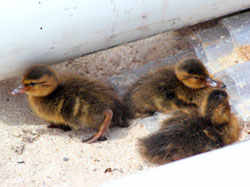
Laysan Ducklings (Anas laysanensis) dubbed Huey, Duey and Luey in front of the hurricane shelter in camp. Credit: M. Wilcox.
A Laysan Duck has hatched her three ducklings underneath the hurricane shelter in camp. She is teaching them to feed on the moths that are attracted to the structure. We also found a mother hen sitting on a nest of three eggs in the northeast naupaka while we were watching Millerbirds this week. These broods constitute a second peak in duck reproduction this year; the first crop of ducklings hatched in late April.
Laysan Ducks are one of the rarest ducks in the world. They only occur here and on Midway Island where they were translocated. These ducks feed on the brine flies along the lake's edge, drink freshwater from natural seeps, and bathe in the ocean. They have also grown accustomed to human presence, and some "camp ducks" have learned that they can find fresh water on tarps and bucket lids around camp after a rainfall.
Other Bird News
The Black-footed Albatross chicks are fledging! They have been practicing their take-offs and landings in the North Desert and around the island for a few weeks, and now they are heading out ocean-ward. When they tire of flying they land in the ocean and paddle around for a while before running atop the water to fly again. There are perils in fledging, and we have already seen a number beaten up by waves and spit back onto shore. We are also keeping our eyes peeled for our first sightings of tiger sharks that will come to prey upon the fledglings.
Laysan Albatross chicks are right behind the albatross in practicing to fly; they too will be fledging by the next blog. Brown Noddies have laid a few eggs around camp and elsewhere, they don't seem to care where they nest—on the ground or atop a 55-gallon water drum.
We have started to see Grey-backed Tern chicks that resemble mottled grey stones against the sand. Christmas Shearwater eggs are also starting to hatch into grey fluff-balls. Bonin Petrels are fledging every day, while Wedge-tailed Shearwaters are laying their eggs in burrows vacated by the Bonins.
Yes, life is all about change here on Laysan!
Spying on the Birds
June 3, 2013 - June 16, 2013
By Megan Dalton
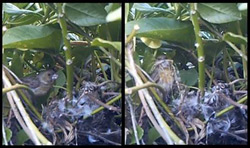
A Laysan Finch caught in the act of stealing nesting material from a recently fledged Millerbird nest. Credit: Megan Dalton.
After Millerbird pairs have fledged their chicks and are through using their nests, we often will find nests on the ground in pieces as if something has torn them apart. Millerbirds have been known to "cannibalize" their old nests and reuse the nesting materials when building new structures.
However, we have also observed Laysan Finches tugging at them benignly without removing any material with their bills. Because we use a torn-apart nest as a clue to look for rebuilding pairs, we wanted to find out who exactly was doing the demolishing, so we set up a few motion-activated game cameras on some recently fledged nests.
After we found one nest thoroughly dismantled, we took down the camera and looked at the video footage. It was quite enjoyable to watch the birds' behavior, and they were seemingly unaffected by our presence in the field. For example, we saw that the banded fledgling that hatched in this nest actually spent quite a bit of time in and around the nest for over two weeks, poking around the structure itself, picking at the rootlets and blades of grass, even sitting in the nest as an adult incubating eggs would!
We also solved the mystery of the nest destruction: Besides the gentle probing of the Millerbird fledgling, there were several giant bill-fulls of nesting material taken not-so-benignly by a female Laysan Finch. But the largest amount of dismantling came three weeks later from the original Millerbird pair themselves who, once they decided that it was time to build a new nest, went full steam ahead in completely tearing apart the old one, taking the materials to an as-yet unknown location and leaving very few leftovers. The young fledgling, of course, had to find a new hangout.
Nature Sighting of the Week
The number of migratory shorebirds on Laysan has dropped dramatically as the majority of them has departed to fly thousands of miles north to their breeding grounds. The Wandering Tattler is one such bird that, after spending around eight months in their wintering grounds on islands in the south-central Pacific or on the coasts of North and South America, makes the long-distance trek—12,000 kilometers or more—to the tundra in Alaska and the Yukon.
The tattlers will waste no time in beginning their breeding activities and, after raising a typical brood of four, will then migrate back beginning in July. The juveniles follow in the fall. We are already missing their ʻulili call, which is their Hawaiian name, and look forward to their return.
Fledgling Explorers on Laysan Island
May 20, 2013 - June 2, 2013
By Michelle Wilcox
We now have at least 100 Millerbirds on Laysan Island! In the past two weeks, we've discovered a few more unbanded adult females nesting with banded males. This brought our number of adults up to 75. The number of Millerbird fledglings for the year is up to 25—closing in on last year's count of 29. There is still plenty of time to exceed that number before the breeding season ends this year.
There seems to be no slowing down: In this two-week period, we've discovered five new nests being built and we are still monitoring five pairs that are incubating eggs, two pairs with nestlings and eight pairs that fledged young.
After three to four weeks of being fed by their parents, the Millerbird fledglings start moving around on their own. They are highly curious, silent, and will show up suddenly near your feet, peering up at you from the exposed edge of a naupaka bush. The fledglings train one eye, then the other on you, noticeably trying to figure out what you are.
By banding chicks in the nest, we can tell where they hatched and compare that to where we detect them later. One adventurous fellow has already been seen exploring one-third of a mile away from the nest where he fledged only six weeks prior. He may have been attracted to Millerbirds in other territories, but he was definitely out exploring his new world. By observation we hope to learn about the new fledglings' movements and their interactions with other Millerbirds.
Nature Sighting of the Week
Over the past few weeks, we have been enjoying the sparkling lights of the night sky with a spotting scope and a good star book. The constellation Corvus has been a great starting point. Easy to spot in the south, this trapezoid of stars is otherwise known as the crow, a messenger to Apollo. It is now a messenger to us, since it helps point our way to the group of stars on the horizon called the Southern Cross. Hawai'i is one of the only places in the United States where you can see from the Southern Cross to the North Star in the same night sky.
We have also been able to see the star Sirius sparkling like a fireworks display, as well as a number of planets including Jupiter, Venus, and Mercury. Grandest of all, we were able to see the rings of Saturn through the spotting scope. The stargazing on Laysan is spectacular. With no civilization or light pollution for up to 800 miles in every direction, how could we expect anything different?
Other Bird News
The Laysan Albatross chicks are losing their down feathers, replacing them with body and wing feathers. They now sport gray down on their too-short primary wing feathers, but they are practicing flapping nonetheless. Flapping while sitting on the ground looks a bit silly, but they have the right idea.
We have a colony of thousands of Sooty Terns that seems to be indecisive about where it wants to lay their eggs en masse this year. They keep touching down in an area, and a few of them lay eggs, but then the rest move to a new area. We continue to see a small number of Pacific Golden-Plovers, Ruddy Turnstones, Sanderlings, Wandering Tattlers, and Bristle-thighed Curlews. We guess most of these birds are probably foregoing their trip to their breeding grounds this year and are going to stay on Laysan through the summer. The more, the merrier: Brown Noddies have come to camp, and they are courting and choosing breeding locations. Also, a very few Tristram's Storm Petrel fledglings have also shown their faces around the island.
Meanwhile, we'll keep counting Millerbirds, stargazing and bird watching here on Laysan. Look for more from us in two weeks!
As Busy as a Millerbird
May 6, 2013 - May 19, 2013
By Megan Dalton
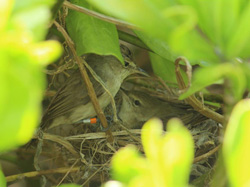
Male Nihoa Millerbird, tagged B/G:S/O, visits his mate at their nest. A chick fledged from this nest on May 17, 2013. Credit: Megan Dalton.
The past two weeks have been quite productive, both for the Millerbirds and for us in the field. We are currently following 23 pairs engaging in breeding behavior, which means Michelle and I are busy trying to keep up with all the activity.
This is not an easy task when there is so much going on at once! We managed to find six new nests, band several nestlings, and observe three Millerbird chicks fledge during the last two weeks. With a handful of pairs working on constructing new nests, and at least 10 more incubating eggs or brooding nestlings, it doesn't look like things will slow down anytime soon!
Very interestingly, we found the pair of Millerbirds reusing a nest in an area we call the Northwest Bowl. They fledged two chicks in mid-April and have apparently decided that the nest is good enough for another go-round, as they are currently incubating one egg there. It is normal to see pairs building a new structure in the same bush where their previous nest was located, and the birds sometimes parasitize the old nest material to build a new nest, but to our knowledge this is the first documented instance of a Millerbird actually reusing an old nest.
Nature Sighting of the Week
Sooty Terns are the latest numerous and noisy bird species to demand our attention. Although flocks have been present behind our camp and in other areas around Laysan since we arrived in March, both the numbers of birds and the sounds they make seem to have increased, making normal activities like conversation and sleep a bit of a challenge. We hope they make up for this soon by giving us many fluffy chicks to look at.
"Sooties" are known for being very aerially inclined--they can spend years on the wing after fledging without ever touching land and are reluctant to land even on the water. They forage by taking fish and other prey at the ocean surface and dive only occasionally. When they finally do come to an island to breed, the tens of thousands of birds spend one to four months circling in the air over the site of their colony before actually setting foot on the ground to lay. Along with Lisianski Island to the northwest, Laysan is home to over half of Hawai'i's breeding Sooty Terns.
Many of the shorebirds seem to be moving on to their breeding grounds in the boreal forest and Arctic tundra, as we are seeing smaller numbers of Wandering Tattlers, Pacific Golden-Plovers, Ruddy Turnstones, and Bristle-thighed Curlews around the island. The only other migrant of note was a group of 25 Sanderlings feeding on the lakeshore, most of them decked out in breeding plumage.
Back to counting Millerbirds. See you in a few days from the beautiful island of Laysan!
Survival and Productivity on Laysan
April 22, 2013 - May 5, 2013
By Michelle Wilcox
Here on Laysan, survival and breeding productivity are two of the main pieces of information we are documenting for the Millerbirds translocated in 2011 and 2012. Our observations show the birds surviving and reproducing admirably.
We have been on the island just over a month and have hopefully gotten eyes on most of the banded Millerbirds. When we left last fall there were 48 banded birds, and now 46 of them have been seen again! This includes both adults and juveniles, which means the survival of both old and young Millerbirds on Laysan was amazingly high over the winter.
As for productivity, there are new Millerbird chicks to report. We have three nests full of newly hatched chicks begging to be stuffed full of green caterpillars, spiders, and flies which they will turn into body mass and feathers. We also have two new fledglings, for a total of 11 fledglings this season, and another seven nests with eggs being diligently incubated by parents.
Nature Sighting of the Week
Life is making new life all around the island, and so our nature sighting of the week goes out to all the brand-new living things. The Masked Boobies patiently incubating eggs tucked under their feet have been rewarded with new babies. The newly hatched chicks have white plucked-chicken skin with a black bill larger than their skull, along with clown-sized feet.
The Great Frigatebirds have been sitting on messy stick nests atop naupaka shrubs, and their single eggs have been hatching too. They rarely let me get a peek of their white-billed baby, and if I get too close they move their head left and right slowly like a banking bi-plane. At the same time, they constantly clack their bills together as though I'm being shelled.
The monk seals have been pupping as well, and we have seen up to 10 moms with pups basking on the beaches of Laysan. We give them a wide berth because they are an endangered species whose numbers have been declining. In addition, there is a danger of the moms hurting or leaving their pup if we disturb them on their restful beach.
There is a nest of Laysan Finches in the bunch grass in front of the kitchen tent in camp. The three nestlings are well-feathered and make a racket of begging when the adults bring food. White Tern chicks have been hatching as well. I saw one yellowish chick that was smaller than a tennis ball and had its bill open and stick-wings spread as though threatening to swallow me whole if I came just a little nearer to the rock he was hatched on. His lovely white-feathered parents were nowhere to be found, probably out foraging for silvery fishes to slide into that open gape.
Our year-round residents, the Laysan Ducks, have been attempting to increase their numbers, with 18 new ducklings seen vacuuming up brine flies at the lake's edge.
Other Bird News
The Laysan and Black-footed Albatross chicks have started to grow their black wing feathers over the last few weeks. Some of the Sanderlings are starting to molt into their breeding plumage, and we have seen a total of 21 recently. We have counted four invasive Cattle Egret adults on the island, but fortunately have not found another nest. Bulwer's Petrels have begun to arrive and bark at each other.
We continue to see Pacific Golden-Plovers, Ruddy Turnstones, Wandering Tattlers (decreasing in numbers), and Bristle-thighed Curlews. Sooty Terns have been performing aerial swarming, and Gray-backed Terns have been seen in good numbers, some sitting on eggs.
Check back in two weeks. We hope to have more good news about the Millerbirds to share with you then!
Flurry of Activity
April 8, 2013 - April 21, 2013
By Megan Dalton (Millerbird monitoring biologist on Laysan)
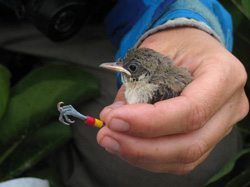
One of five Nihoa Millerbird nestlings banded so far this 2013 season on Laysan. This particular chick was banded Y/R:BK/Y (yellow over red on the left leg, black over yellow on the right leg) at approximately 13 days old. Credit: Megan Dalton.
My first month on Laysan, where I'm helping to monitor the recently reintroduced Millerbird population, has been a bit of a whirlwind. So many new sights and sounds to take in and places to explore on this island, while simultaneously trying to get settled into camp and, most excitingly, jumping right into our Millerbird monitoring tasks.
It's been a challenge to catch up on all the Millerbirds' movements, pairings, and activities since the field crew was evacuated last fall, especially since there appear to be many more younger, unbanded birds in the area trying to stake out their own territories amongst the older, more experienced birds. A rather pleasant problem to have with this recently translocated population - more Millerbird activity than we can handle!
Millerbird breeding wave
While it is impossible to say for certain, we think we arrived at the beginning of a new breeding wave. Males have been busy singing their energetic songs and both sexes have been observed carrying nesting material, such as grasses and seabird feathers, to their nest sites. Certain pairs were already carrying food items to their nests, indicating that their eggs had already hatched and that they were feeding one or more nestlings! So far we have found 11 nests and have confirmed 9 successful fledglings. Several pairs are currently incubating eggs, so we expect that number will increase soon. An auspicious start to the breeding season for sure!
Michelle and I were also able to participate in a first for this project - banding nestlings at the nest - which was both extremely thrilling and terrifying at the same time. We took every precaution in doing this safely since, as with many passerines, there is potential to cause the nestlings to prematurely fledge. There is a small window of opportunity between when the young birds' legs are the appropriate size for banding and when they are still sedentary in the nest. (They get jumpier as they get older!)
We are happy to report that the five nestlings we have banded all stayed in their nests like good children and successfully fledged 4-8 days later. They will continue to be fed by their diligent parents for a month or so while they learn how to make it on their own.
Nature site of the week
It's been hard to ignore the calls of the noisy Wedge-tailed Shearwaters. I think they've been aiming for their chance to be the 'Nature Sighting of the Week' feature on this blog. Okay, wedgies, you win, here goes. The Wedge-tailed Shearwater is a long-lived, medium-sized pelagic seabird that feeds on fish and squid at the surface of the water. These birds return to low, sandy areas at this time of year where they dig nesting burrows in the ground and will eventually lay their one egg of the season.
The wedgies are currently in the courting and pair-bonding phase of their breeding cycle and spend much of their nights calling and moaning to each other, alternately sounding like crying babies (WAAH!) or someone badly imitating a ghost (ooooOOOOooo!). They are working hard on their burrows, some excavating new ones and others renovating old ones. Like all seabirds, the adults invest a lot of time and energy into their one egg: 53 days of incubation and over three months of feeding the slow-growing chick. If everything goes right for the chick, it can live many years. The oldest Wedge-tail on record was 29 years old!
Other bird news
Besides the regular Ruddy Turnstones, Pacific Golden-Plovers, Wandering Tattlers and Bristle-thighed Curlews, we haven't seen too much of note aside from a handful of Long-billed Dowitchers and Sanderlings and one lone Red Phalarope. The Short-tailed Albatross hasn't been seen in two weeks and probably won't reappear until the fall. The Laysan Ducks are in the midst of their breeding season, with a high count of 11 ducklings this week.
Join us again in a few days for more sights and sounds from Laysan.
Return to Laysan
April 8, 2013
By Michelle Wilcox

Laysan Island's human population. Back row, left to right: Andrea Kristof, Justin Yeh, Andy Bridges, Ian Thomas. Front row, left to right: Brianna Ordung, Megan Dalton, Michelle Wilcox. Credit: Megan Dalton.
After being closed since November 2012, the camp on the 1,016-acre coral atoll known as Laysan Island was reopened in late March 2013 and is now staffed with five USFWS personnel and two Millerbird biologists.
I was lucky enough to return to Laysan Island along with Megan Dalton, the newest biologist. Together we will continue monitoring the newly translocated Millerbirds to try to determine how many survived the winter and then monitor them throughout the summer. We hope to discover how many new chicks have fledged, and where on the island they are living. In the first couple of weeks we have already seen more than 38 individual Millerbirds and are expecting to find even more in time.
The birds began nesting on Valentine's Day last year, so we predicted they would be nesting when we arrived this year. The birds are indeed busy and Megan and I have found six pairs nesting so far - three pairs have nests with chicks in them and three pairs are building nests. Additionally, we have found males defending new territories adjacent to the area they favored last year. The naupaka shrubland on the north end of the island appears to be the Millerbirds' favorite area.
Although Millerbirds are our focus here on Laysan, our 'Nature Sight of the Week' has to go to the tens of thousands of Laysan Albatross chicks sitting all over the island. Their parents had just started arriving in the fall when we left and the island is now a very different place, so much more full of life and activity. There is a grey, downy chick the size of an overweight bowling pin under my clothesline. During the heat of the day he waddles unsteadily into the shade of my weatherport platform, but he must return to the patch of ground where he hatched or his parents will not feed him with regurgitated fish, fish eggs and squid when they return from foraging flights, which can cover thousands of miles.
The Laysan Albatross do not begin breeding until around their eighth year of life, but starting at age three they begin to return yearly to Laysan during the breeding season to practice their courtship dance, to find and defend a territory (males), and to find a life-long mate. This means that in addition to the chicks and their itinerant parents there are tens of thousands of young adults on the island who spend most of their days calling, clacking, and dancing. What a life.
In addition to the Laysan and Black-footed Albatross, there is one lone Short-tailed Albatross who returned again this breeding season to what we call the "northeastern desert". Along the brine lake edge we have seen two Ruff, four Long-billed Dowitchers, two Red Phalaropes, 12 Sanderlings, in addition to the large numbers of Wandering Tattlers, Pacific Golden-Plovers, and Ruddy Turnstones. We have seen one Cattle Egret near the grove of coconut tree snags and we have seen a good number of Bristle-thighed Curlews around the island.
Our plan is to post these blogs every two weeks. We will include updates on the status of the millerbird population, stories about specific individuals and information on all the other natural and unnatural wonders on Laysan.
View 2012 Updates.
View 2011 Updates.
Click Here for photos, videos and more information (you will be directed to a U.S. Fish and Wildlife Service website).
